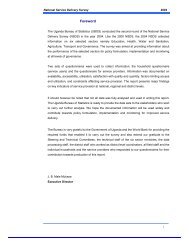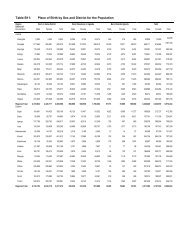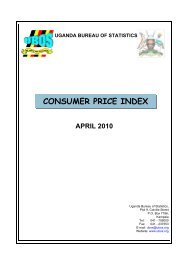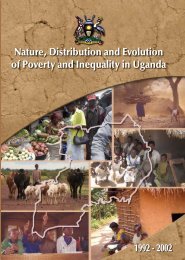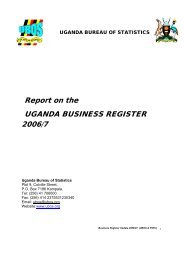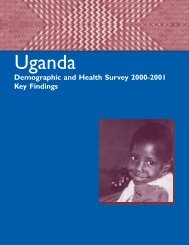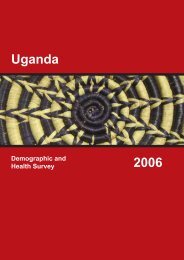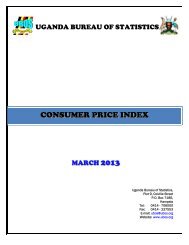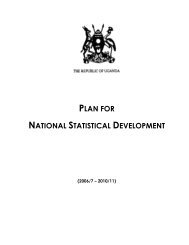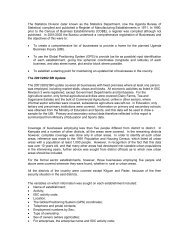Census Analytical Report - Uganda Bureau of Statistics
Census Analytical Report - Uganda Bureau of Statistics
Census Analytical Report - Uganda Bureau of Statistics
Create successful ePaper yourself
Turn your PDF publications into a flip-book with our unique Google optimized e-Paper software.
The 2002 Population and Housing <strong>Census</strong>SummaryThe total number <strong>of</strong> children increased from 9 million in 1991 to 13.7 million in 2002;the proportion <strong>of</strong> children in <strong>Uganda</strong> increased from 54 percent in 1991 to 56 percentin 2002.A total <strong>of</strong> 3.2 million children were vulnerable at the time <strong>of</strong> the census. Thirteenpercent <strong>of</strong> the children were orphans, having increased from 11.6 percent in 1991.About 7 percent <strong>of</strong> the children aged 5 – 17 years were child labourers. Amongchildren in the same age range, 2 percent had a disability 43 percent <strong>of</strong> the CWD’shad not received any rehabilitation for the disability at the time <strong>of</strong> the census. Mostchildren were living in households with at least one child and 42,000 children wereheading households.The proportion <strong>of</strong> young people aged 10 -30 comprised <strong>of</strong> 43 percent in 2002 with thefemale youth outnumbering their male counterparts. More than 50 percent <strong>of</strong> themales were attending school compared to 42 percent <strong>of</strong> the females.Seventy percent <strong>of</strong> the working female youth (aged 14 -30) were unpaid familyworkers compared to 27 percent <strong>of</strong> the males in the same age bracket. Twentypercent <strong>of</strong> the youth (aged 14 -30) were idle with females being idler than their malecounterparts. Young mothers stood at 18 percent with higher proportions among thosewho had never been to school.The total population <strong>of</strong> older persons doubled between 1991 and 2002. About 1 inevery 5 <strong>of</strong> the older persons had a disability while more than 13 percent <strong>of</strong> olderpersons lived alone.The national disability prevalence rate was 4 percent with the Northern region havingthe highest percentage. The prevalence increased with age. 13 percent <strong>of</strong> the PWD’shad multiple disabilities. 45 percent did not receive any rehabilitation measures. Ingeneral households with a PWD had lower welfare indicators compared to thosehouseholds without a PWD.124



